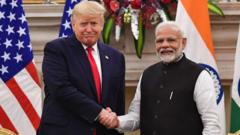Chinese garment factories, particularly in Guangzhou, face an existential crisis due to newly imposed tariffs and increased operational costs stemming from changes in U.S. import tax policies. Liu Miao, a factory owner with years of experience selling to American buyers via Amazon, has found his profit margins slashed, prompting a reevaluation of business strategies amidst rising economic challenges.
### China’s Apparel Industry Confronts Major Challenges Amid New U.S. Tariffs

### China’s Apparel Industry Confronts Major Challenges Amid New U.S. Tariffs
As a U.S. tax loophole closes, Chinese garment manufacturers are compelled to seek alternative avenues for market viability.
Many factories like Mr. Liu's thrived in a booming e-commerce market where the ability to ship goods tax-free under certain thresholds fueled their success. A vibrant mix of domestic innovation and foreign demand characterized this dynamic, leading to considerable economic growth within the region. However, the escalating trade tensions between the United States and China have put significant pressure on these businesses, forcing them to contemplate their future in a climate of uncertainty and rising costs.
In recent weeks, garment makers have reported a stark decline in revenue as the burdensome tariffs make selling to U.S. consumers increasingly untenable. With workers facing stagnating wages and operational feasibility at stake, these factories grapple with the potential of downsizing or relocation to maintain competitiveness in an evolving global market.
The situation encapsulates the broader narrative of globalization and the precarious balance that industries must maintain when confronted with such geopolitical shifts. The future for Chinese garment factories hangs in the balance, as their ability to adapt will determine their survival in an increasingly fractious global trade landscape.
In recent weeks, garment makers have reported a stark decline in revenue as the burdensome tariffs make selling to U.S. consumers increasingly untenable. With workers facing stagnating wages and operational feasibility at stake, these factories grapple with the potential of downsizing or relocation to maintain competitiveness in an evolving global market.
The situation encapsulates the broader narrative of globalization and the precarious balance that industries must maintain when confronted with such geopolitical shifts. The future for Chinese garment factories hangs in the balance, as their ability to adapt will determine their survival in an increasingly fractious global trade landscape.





















